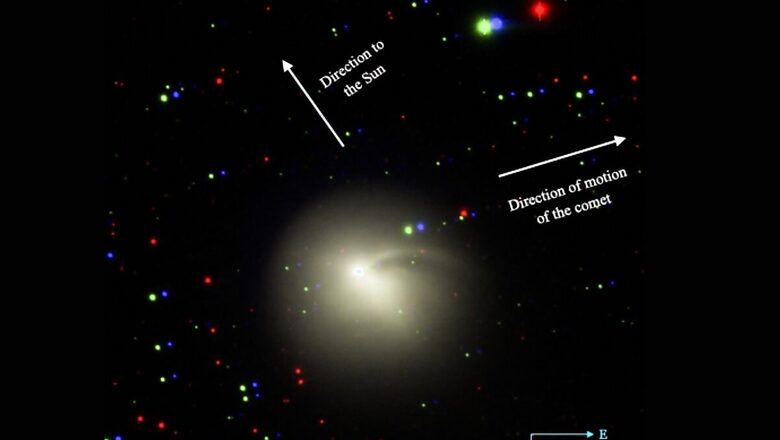
views
The astronomers from the Indian Institute of Astrophysics (IIA) have captured stunning images of a peculiarly-shaped comet using the Himalayan Chandra Telescope (HCT) in Ladakh.
Discovered almost 200 years ago, P12/Pons-Brooks is one of the brightest known periodic comet that sweeps past the Earth after every 71 years. It is currently gliding through the Solar system far away from Earth, but is likely to have its closest approach to the Earth next year in June. The images were captured by the two metres-long telescope at the Indian Astronomical Observatory (IAO) perched atop Mt. Saraswati, Digpa-ratsa Ri in Hanle at an altitude of about 15,000 feet. It is remotely operated from the institute’s CREST Campus in Hosakote, Karnataka.
When comets get closer to the Sun, they produce sudden outbursts of jets of gas and dust creating a spectacular event often spotted by large telescopes. The images taken by the telescope on the night of November 21 show a striking bright arc on the top right, which shows such bright outburst from the coma (centre of the comet). There is a darker lane below, which is the shadow cast by the nucleus of the comet on the surrounding gas.
The spherical atmosphere seen around the centre is about 3.5 lakh km in diameter.
COMETS AND THEIR SPECTACULAR OUTBURSTS
“The comet has had four outbursts already since July, each of which released a few billion kg of gas and dust from inside its surface and made it briefly brighten by almost 100 times,” said Margarita Safonova, an astronomer at IIA, who made the observations with a team. The latest outburst, believed to be eruptions of built-up gas from cracks in the icy crust due to heating by sunlight, was as recent as November 14.
This comet has captured the attention of night gazers and astronomers worldwide because of the bright show it puts up occasionally. During its earlier approaches to the Sun, astronomers had observed multiple ejections of gas and dust from its nucleus, which typically gave it an appearance of being horned. Its peculiar shape has led many to call it a ‘Devil Comet’ or the ‘Millennium Falcon’.
The astronomers explained that the photograph produced by the Hanle observatory is an overlay of individual exposures using three different colour filters. “Since the comet is moving rapidly across the sky, when we co- add the three images centred on the comet, we see the stars from each of the exposures at a different location and in their respective filter colours,” said the team which observed the stunning event.
WHEN CAN YOU SEE IT?
It is just the beginning. The comet is expected to become even brighter in the coming months and may even become a naked eye comet next year, say scientists before it returns to the outer solar system for next 71 years.
This comet will pass closest to the Sun next year on 21 April 2024 and will have its closest approach to Earth on 2 June 2024, when it will be 1.5 times the Earth-Sun distance away. It is expected that this comet will be easily seen with small telescopes or a binocular, or even with the naked eye at that time.
“Comets always hold great fascination for all of us, and we will photograph this comet with our telescopes in the coming months to share its journey with everyone,” said Niruj Mohan Ramanujam, who heads the outreach section at IIA.















Comments
0 comment